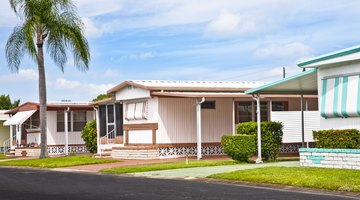How to Insulate the Underbelly of a Mobile Home
Table of Contents
Insulating the underbelly of a mobile home can greatly improve your energy bills. Given the location, however, it's not as simple as rolling out some fiberglass. In fact, fiberglass works poorly under a mobile home, where moisture can be an issue. Spray foam or foam boards are your best options.

Once upon a time, mobile homes meant shoddy construction and poor performance. Insulation in them was poor if it existed at all, and the homes had short life spans that made investing in upgrades seem foolish. Thankfully, times have changed, and there are some very nice mobile homes throughout the nation. Fixing and upgrading your home's insulation now makes perfect sense if and when the need arises. Modern materials also give you more insulation choices than you had before.
Closed-Cell Spray Foam
Without question, the best type of insulation for the underbelly of a mobile home is closed-cell spray foam insulation. An open-cell foam can also work but is more likely to capture and hold water, which can cause mold and mildew while minimizing the material's insulating properties. Spray foam is an excellent choice because there is nowhere it can't go. It expands to fill in even the smallest holes and cracks and then hardens to stay firmly in place where you need it.
The one caveat of spray foam insulation is that it requires professional insulation. You can't always see what you're doing when spraying it in place, so you need to have extensive knowledge of the foam and how to use it. Spray foam also requires special installation equipment. The lack of DIY installation adds to the cost of the foam, but it also gives you an excellent excuse not to have to crawl under the trailer to work. There is only about 14 inches of space under there, so it's not for the claustrophobic.
Rigid Foam Board Insulation
After spray foam, rigid foam board is the next best type of insulation for the belly of your mobile home. You have several foam boards from which to choose. Molded expanded polystyrene (EPS) works well. This is the least expensive foam board, and it has an insulation value (R-value) of 3.6 to 4 per inch of thickness. Similarly, extruded polystyrene (XPS) has an R-value of about 5 per inch of thickness. XPS is made from foam pellets, which make it a bit smoother and denser than EPS.
Finally, you may opt for polyisocyanurate (ISO). ISO has the highest R-value at 7 to 8 per inch of thickness. ISO's high R-value comes from gasses trapped within the foam, however, making this type of foam much more prone to off-gassing. This can make your mobile home smell odd and can reduce the insulative value of the foam over time as the gas escapes.
One of the big advantages of foam is that you can stack it for added insulation. Some mobile homeowners, for example, cut strips of foam to fit between their floor joists. They then stack these foam strips on top of each other as deeply as the floor joists will allow. A large piece of uncut foam is then attached underneath all the floor joists to finish or "cap" the insulation, and a new polystyrene belly wrap is installed under the foam.
How Far Should I Go?
If your mobile home was built before 1976, chances are it has little to no insulation, and whatever is under your mobile home currently is a mess. If you need to add insulation, it's probably best to remove the home's belly wrap along with any insulation present and just start over. The materials used may be inadequate and have likely succumbed to age.
In 1976 and beyond, however, the U.S. government put new rules in place that required better construction methods for mobile homes. In this case, how far you go will depend on what you find under your house. If you're repairing an issue like a water leak, you may be able to simply cut an "X" in your belly wrap, remove and replace any wet insulation, and patch the belly wrap hole. If you're satisfied with your mobile home insulation's performance, there is no need to replace it all.
References
Writer Bio
Writing professionally since 2008, Michelle Miley specializes in home and garden topics but frequently pens career, style and marketing pieces. Her essays have been used on college entrance exams and she has more than 4,000 publishing credits. She holds an Associate of Applied Science in accounting, having graduated summa cum laude.
More Articles



